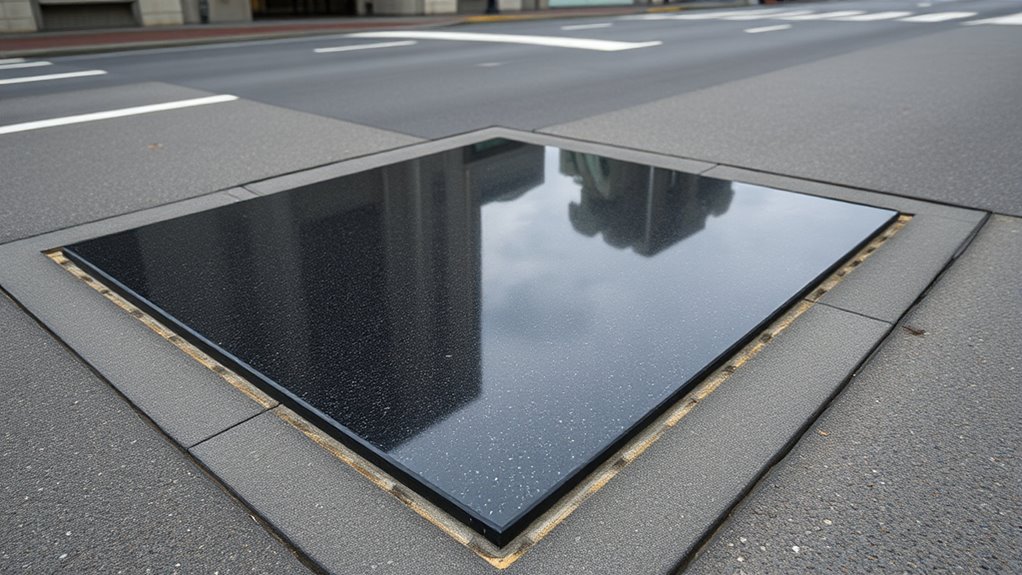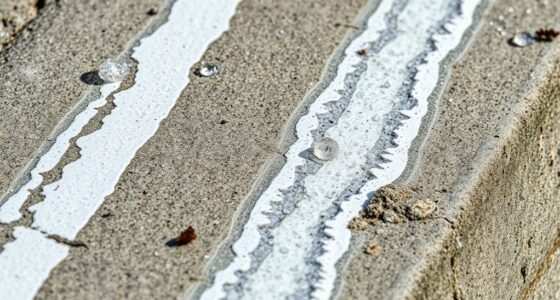Hidden catch basins blend seamlessly into urban landscapes, effectively managing stormwater without disrupting visual appeal. These basins are designed to look like natural features or landscape elements, using subtle materials, clever placement, and aesthetic tricks like camouflage or artistic finishes. Properly installed, maintained, and integrated with smart technology, they prevent flooding while staying out of sight. Discovering how these clever solutions work will reveal surprising ways to keep cityscapes both functional and beautiful.
Key Takeaways
- Utilize low-profile covers or flush-mounted designs to make catch basins blend seamlessly with ground surfaces.
- Incorporate natural materials and landscape elements like plants or gravel to camouflage access points.
- Choose discreet locations that naturally integrate into the environment, such as within planting beds or paved pathways.
- Apply color-matched pigments or matte finishes to minimize visual contrast and conceal the basin.
- Explore artistic or multi-functional covers, like murals or seating, to disguise infrastructure while maintaining accessibility.
The Role of Catch Basins in Urban Drainage Systems

Catch basins play a crucial role in urban drainage systems by effectively collecting and directing stormwater runoff. When rain falls, water flows across streets, parking lots, and other surfaces, picking up debris and pollutants. The catch basin acts as a first line of defense, capturing this runoff through its grate or inlet. Inside, a sump or basin traps debris, preventing it from clogging pipes further downstream. By channeling water into underground pipes, catch basins help prevent flooding, erosion, and water damage to infrastructure. They also protect water quality by trapping pollutants before they reach natural waterways. Additionally, proper maintenance of stormwater management systems ensures their continued effectiveness. Without these systems, urban areas would face increased flood risks and environmental issues, making catch basins essential for maintaining safe, functional cities.
Design Strategies for Discreet and Effective Installation

Effective installation of catch basins requires thoughtful design strategies that prioritize both functionality and aesthetics. You should select locations that naturally blend into the landscape, avoiding obvious spots that draw attention. Use subtle grading techniques to direct water flow toward the basin without creating visible disruptions. Incorporate low-profile covers or flush-mounted designs that sit level with the surrounding surface, reducing visual impact. Consider integrating the basin into existing landscape features, such as planting beds or paved pathways, to conceal it further. Proper planning involves aligning the basin’s size and outlet with the drainage requirements while maintaining unobtrusive access for maintenance. Additionally, selecting products with glycolic acid can enhance the appearance of skin in surrounding areas, ensuring the system remains discreet yet highly effective. By focusing on seamless integration and strategic placement, you ensure the system remains discreet yet highly effective.
Materials and Construction Techniques for Camouflaged Catch Basins
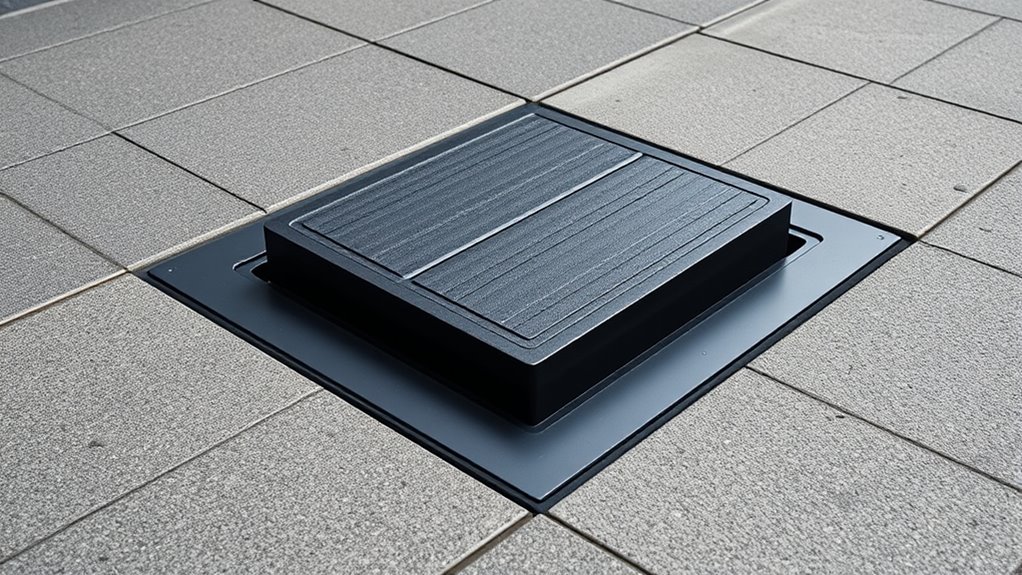
Choosing the right materials and construction techniques is essential for creating camouflaged catch basins that blend seamlessly into their surroundings. Start with natural materials like stone, brick, or textured concrete that match the environment’s aesthetic. Use color-matched pigments or finishes to help the basin blend in further. Incorporate camouflage elements such as moss, gravel, or plantings around the structure to disguise its presence. When building, ensure the basin’s size and shape mirror nearby features, maintaining visual consistency. Employ techniques like flush installation to make the basin level with the ground surface, avoiding raised edges that catch the eye. Proper sealing and drainage design also prevent runoff issues while keeping the basin discreet. Additionally, researching retail hours can help coordinate installation schedules around store closures or availability of materials, ensuring a smooth project process. These choices help the basin remain hidden without sacrificing functionality.
Innovative Approaches to Concealment and Aesthetic Integration
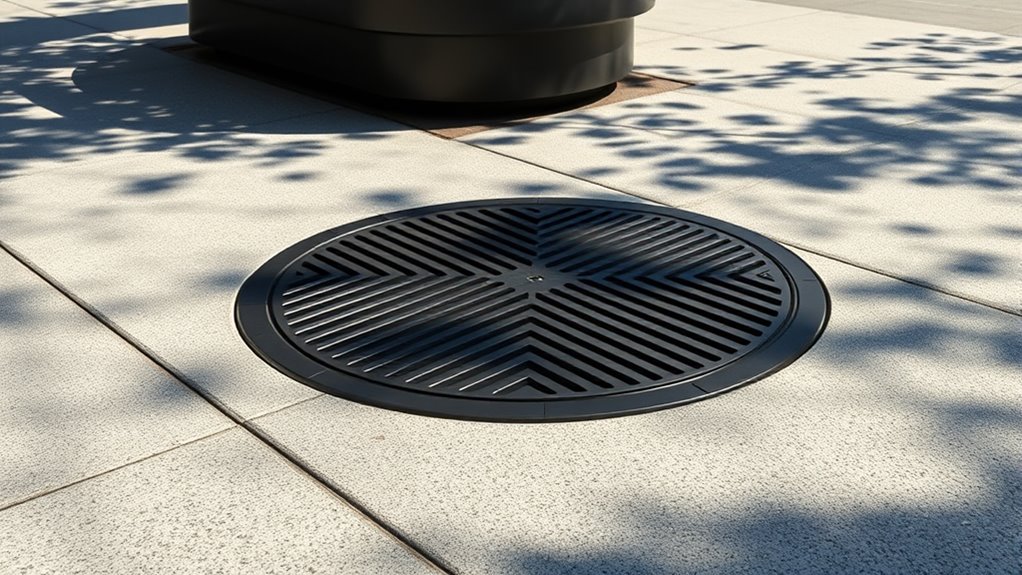
You can enhance catch basin concealment by using clever camouflage design techniques that blend with the surrounding environment. Multi-functional cover systems not only hide the basin but also add utility, like seating or planters. Artistic integration strategies transform these structures into visually appealing elements that complement your landscape or urban design. Incorporating elements of rustic decor can further enhance the seamless integration of the basin into a countryside or farmhouse aesthetic.
Camouflage Design Techniques
Camouflage design techniques for catch basins have evolved beyond simple color matching, embracing innovative methods that blend functionality with aesthetics. You can now incorporate materials and patterns that mimic surrounding surfaces, making the units less noticeable. Techniques include using textured finishes that resemble pavement or landscaping, applying digital camo patterns, or integrating natural elements like stones or plants. Surface treatments such as matte coatings reduce glare, while embedded visual cues guide users subtly. Incorporating these approaches ensures the catch basin blends seamlessly into its environment without compromising performance. You also might consider designing covers that mimic nearby textures or colors. These methods help hide the infrastructure, maintaining visual harmony and reducing visual clutter in urban or natural settings.
Multi-Functional Cover Systems
Multi-functional cover systems are transforming the way catch basins integrate into their surroundings by combining concealment with added features that enhance usability and safety. These covers do more than hide the basin; they serve as access points, flow regulators, or even seating areas. You can find designs made from durable materials that blend seamlessly with pavement, landscaping, or urban decor. Some systems include sensors for real-time monitoring of water levels or flow rates, helping prevent flooding or blockages. Others incorporate anti-slip surfaces or reinforced structures to improve safety for pedestrians and maintenance crews. Additionally, material durability plays a crucial role in ensuring these covers withstand harsh environmental conditions over time. By integrating multiple functions into a single cover, you reduce clutter and maintain aesthetic appeal, all while ensuring the catch basin remains accessible, safe, and efficient in managing water runoff.
Artistic Integration Strategies
Innovative artistic strategies are reshaping how catch basin covers blend seamlessly into their surroundings, transforming functional elements into visual enhancements. By integrating art into design, you can turn covers into murals, mosaics, or sculptures that complement their environment. These approaches not only hide the infrastructure but also add aesthetic value to public spaces. Techniques include:
- Using local artwork or cultural motifs
- Incorporating natural materials for camouflage
- Designing covers that mimic pavement or landscaping
- Embedding LED lights for subtle illumination
- Creating interactive or dynamic visual elements
This integration enhances urban beauty while maintaining functionality. By thinking creatively, you can make catch basins virtually invisible, turning utilitarian objects into artful features that delight residents and visitors alike. Additionally, understanding environmental considerations ensures these artistic integrations promote sustainability and ecosystem protection.
Maintenance Challenges and Solutions for Hidden Infrastructure

Maintaining hidden catch basins presents unique challenges because their concealed locations make inspections and repairs difficult. You often can’t see the basin directly, so you rely on access points like manholes or surface grates, which may be infrequent or hard to locate. Sediment buildup, debris, and biological growth can clog the system, leading to flooding or water quality issues. To address these problems, regular remote sensing inspections, such as CCTV camera scans, are essential. Installing clear, accessible access points and using smart monitoring systems can help you identify issues early. You may also need specialized equipment or trained personnel to safely perform maintenance in confined or hard-to-reach spaces. Proactive planning and innovative technology are key to keeping hidden infrastructure functional and effective, especially considering the side effects of neglecting maintenance that can compromise system performance.
Safety Considerations and Public Awareness

Because hidden catch basins are often located beneath streets and public areas, ensuring safety during inspection and maintenance is critical. You need to be aware of potential hazards and follow proper protocols to prevent accidents. Public awareness is equally important, so informing residents about the presence and purpose of these basins helps prevent vandalism and misuse. To stay safe, consider these points:
- Use proper signage around work zones
- Wear personal protective equipment
- Mark and secure open access points
- Educate the community about the basins’ role
- Follow local safety regulations and procedures
- Regular maintenance can also reduce the risk of hazards, ensuring the longevity and safety of the infrastructure.
Future Trends in Invisible Stormwater Management
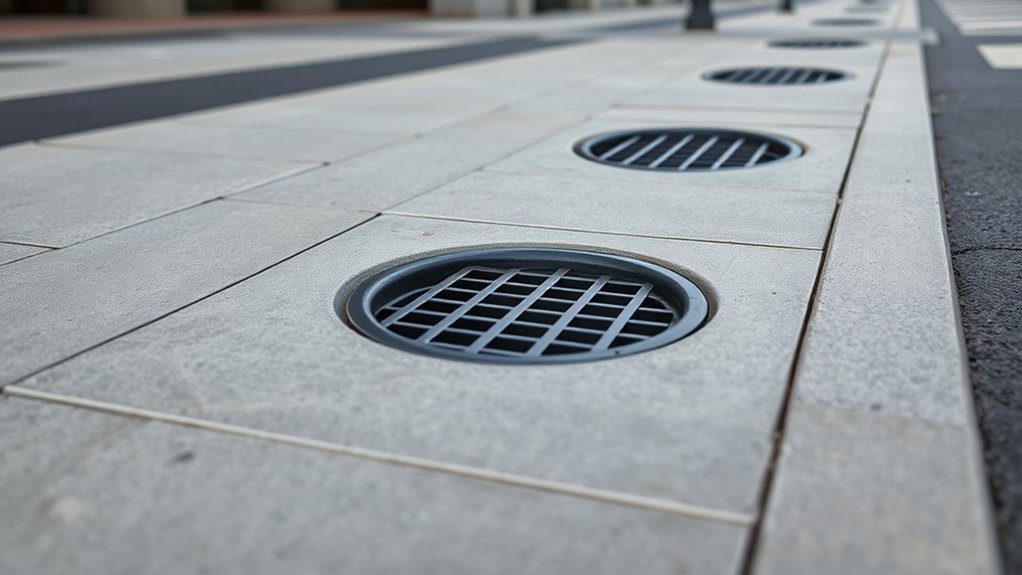
Future stormwater management will increasingly rely on smart infrastructure that adapts to changing conditions. You’ll see more innovative water technologies that optimize flow and reduce pollution automatically. Additionally, sustainable urban designs will integrate these systems seamlessly into city landscapes, making them both effective and unobtrusive. Incorporating vertical storage solutions can further enhance space efficiency within urban environments.
Smart Infrastructure Integration
Smart infrastructure is transforming stormwater management by seamlessly integrating advanced technology into existing urban systems. You’ll see sensors embedded in catch basins that monitor water flow and quality in real-time, enabling quick responses to flooding or pollution. Data analytics optimize drainage patterns, preventing backups and reducing overflow risks. Automated controls adjust flow rates based on weather forecasts, ensuring efficient water handling. These innovations allow cities to collect valuable environmental data, improving long-term planning. Moreover, AI-driven security measures ensure that the infrastructure remains protected from cyber threats that could disrupt operations. Cyber threats can compromise critical systems, making robust security integration essential for resilience. This approach creates smarter, more responsive stormwater systems that enhance urban resilience while maintaining a clean, safe environment.
Adaptive Water Technologies
Advancements in adaptive water technologies are shaping the next generation of invisible stormwater management systems. You now have tools that respond dynamically to changing conditions, optimizing water flow and reducing flooding risks. Smart sensors monitor rainfall, soil moisture, and runoff in real time, adjusting flow rates automatically. This guarantees efficient water capture without disrupting urban aesthetics. Adaptive systems also incorporate modular components that can expand or contract based on storm intensity, providing flexibility and resilience. These technologies minimize the need for extensive infrastructure, saving space and costs. By integrating data-driven controls, you gain precise management of stormwater, preventing overflows and pollution. As these innovations evolve, they promise smarter, more unobtrusive solutions that seamlessly blend into the urban landscape while safeguarding communities from water-related issues.
Sustainable Urban Design
As cities pursue more sustainable development, integrating invisible stormwater management systems becomes essential for balancing urban growth with environmental responsibility. Future trends focus on embedding these systems into existing infrastructure to minimize visual impact. You’ll see a shift toward green roofs, permeable pavements, and underground reservoirs that blend seamlessly into cityscapes.
- Utilizing smart sensors for real-time water flow monitoring
- Designing multifunctional landscapes that support both recreation and water management
- Employing modular underground storage solutions for flexibility
- Incorporating natural filtration methods like bioretention areas
- Promoting policies that incentivize green infrastructure adoption
These approaches help cities manage runoff efficiently while maintaining aesthetic appeal. As you plan new developments, prioritizing invisible stormwater solutions guarantees sustainability without sacrificing urban vibrancy.
Frequently Asked Questions
How Do Hidden Catch Basins Impact Local Flood Control?
Hidden catch basins improve local flood control by efficiently capturing runoff before it causes flooding. You can rely on them to discreetly collect debris and excess water, preventing blockages and water backups. Since they’re concealed, they don’t disrupt the landscape’s aesthetics. Regular maintenance guarantees they function properly, helping you avoid flood damage and protect your property during heavy rains. These basins are essential for effective stormwater management in your area.
Are There Environmental Benefits to Discreet Stormwater Management?
Ever wondered if discreet stormwater management offers environmental perks? It does. By blending catch basins into surroundings, you reduce visual pollution and protect urban aesthetics. Additionally, these systems help prevent water pollution by capturing debris and contaminants before they reach natural waterways. They also promote groundwater recharge, supporting local ecosystems. So, not only do you maintain beauty and safety, but you also contribute to healthier, more resilient environments.
What Are the Cost Differences Between Visible and Hidden Catch Basins?
Hidden catch basins typically cost more upfront than visible ones because of their specialized design and installation requirements. While visible basins are easier and quicker to install, hidden basins demand precise placement and often more durable materials, increasing expenses. However, hidden basins can save money long-term by reducing maintenance costs and improving aesthetics. Your choice depends on balancing initial investment with long-term benefits and project-specific needs.
Can Hidden Basins Be Retrofitted Into Existing Urban Areas?
Think of retrofitting hidden basins as fitting a secret pocket into your urban jacket. You can indeed retrofit them into existing areas, but it’s like adding a hidden compartment—you’ll need careful planning, excavation, and integration with current infrastructure. Costs vary based on space and complexity, but with proper design, you can seamlessly incorporate these basins without disrupting the city’s flow. It’s a smart upgrade that keeps your city sleek and efficient.
How Do Concealed Catch Basins Affect Urban Wildlife and Ecosystems?
Concealed catch basins can impact urban wildlife and ecosystems by reducing habitat availability and disrupting natural water flow. You might notice fewer animals relying on these areas for shelter or foraging, and water quality could decline if pollutants aren’t properly filtered. To minimize harm, you should consider integrating wildlife-friendly designs and maintaining proper filtration systems, ensuring these basins support both urban infrastructure and local ecosystems effectively.
Conclusion
Did you know that nearly 60% of urban flooding issues could be mitigated with better-hidden catch basins? By choosing discreet designs and innovative materials, you can seamlessly integrate drainage systems into cityscapes without sacrificing safety or aesthetics. Embracing these hidden solutions not only protects your community from water damage but also enhances visual appeal. As technology advances, adopting invisible stormwater management becomes essential for smarter, more resilient urban environments.
